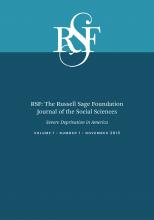Research ArticleI. Severe Deprivation Among the Young and Old
Open Access
Trends in Deep Poverty from 1968 to 2011: The Influence of Family Structure, Employment Patterns, and the Safety Net
Liana Fox, Christopher Wimer, Irwin Garfinkel, Neeraj Kaushal, JaeHyun Nam, Jane Waldfogel
RSF: The Russell Sage Foundation Journal of the Social Sciences November 2015, 1 (1) 14-34; DOI: https://doi.org/10.7758/RSF.2015.1.1.02
Liana Fox
aPostdoctoral researcher at the Swedish Institute for Social Research, Stockholm University
Christopher Wimer
bResearch scientist and co-director of the Center on Poverty and Social Policy at the ColumbiaSchool of Social Work
Irwin Garfinkel
cProfessor of Contemporary Urban Problems at the Columbia School of Social Work
Neeraj Kaushal
dProfessor at the Columbia School of Social Work
JaeHyun Nam
eGraduate student at the Columbia School of Social Work
Jane Waldfogel
fCompton Foundation Centennial Professor for the Prevention of Children's and Youth Problems at the Columbia School of Social Work

REFERENCES
- ↵
- Blank, Rebecca M
- ↵
- Blank, Rebecca M
- ↵Cancian, Maria, and Deborah Reed. 2009. “Family Structure, Childbearing, and Parental Employment: Implications for the Level and Trend in Poverty.” In Changing Poverty, Changing Policies, edited by Maria Cancian and Sheldon Danziger. New York: Russell Sage Foundation.
- ↵Casper, Lynne M., Philip N. Cohen, and Tavia Simons. 1999. “How Does POSSLQ Measure Up? Historical Estimates of Cohabitation.” Working Paper 36. Washington: U.S. Census Bureau, Population Division.
- ↵Citro, Constance, and Robert Michael, eds. 1995. Measuring Poverty: A New Approach. Washington, D.C.: National Academies Press.
- ↵DeNavas-Walt, Carmen, and Bernadette D. Proctor. 2014. “Income and Poverty in the United States: 2013.” Current Population Reports, series P60, no. 249. Washington: U.S. Government Printing Office for U.S. Census Bureau. Available at: https://www.census.gov/library/publications/2014/demo/p60-249.html (accessed February 12, 2020).
- ↵Edin, Kathryn, and Laura Lein. 1997. Making Ends Meet: How Single Mothers Survive Welfare and Low-Wage Work. New York: Russell Sage Foundation.
- ↵
- Feenberg, Daniel, and
- Elisabeth Coutts
- ↵Fisher, Gordon M. 1992. “The Development of the Orshansky Poverty Thresholds and Their Subsequent History as the Official U.S. Poverty Measure.” Experimental Poverty Measures Working Paper. Washington: U.S. Census Bureau. Available at: http://www.census.gov/hhes/povmeas/publications/orshansky.html (accessed October 1, 2015).
- ↵
- ↵
- Fox, Liana,
- Wen-Jui Han, ,
- Christopher Ruhm, , and
- Jane Waldfogel
- ↵Ganong, Peter, and Jeffrey B. Liebman. 2013. “The Decline, Rebound, and Further Rise in SNAP Enrollment: Disentangling Business Cycle Fluctuations and Policy Changes.” Working Paper 19363. Cambridge, Mass.: National Bureau of Economic Research.
- ↵Garner, Thesia I. 2011. “Developing Thresholds for the Supplemental Poverty Measure.” Paper presented at the Annual Meeting of the Allied Social Science Associations (ASSA), Society of Government Economists Session (SGE). Denver, Colo. (January 3, 2011).
- ↵
- Grogger, Jeffrey
- Hoynes, Hilary W
- ↵Hoynes, Hilary W. 2014. “A Revolution in Poverty Policy: The Earned Income Tax Credit and the Well-Being of American Families.” Pathways, Summer 2014, 23–27. Available at: http://www.web.stanford.edu/group/scspi/_media/pdf/pathways/summer_2014/Pathways_Summer_2014.pdf (accessed October 1, 2015).
- ↵
- Hutto, Nathan,
- Jane Waldfogel, ,
- Neeraj Kaushal, , and
- Irwin Garfinkel
- ↵
- ↵ITWG. 2010. “Observations from the Interagency Technical Working Group on Developing a Supplemental Poverty Measure.” Report to the U.S. Census Bureau. Washington: U.S. Government Printing Office. Available at: http://www.census.gov/hhes/www/poverty/SPM_TWGObservations.pdf (accessed October 1, 2015).
- ↵Meyer, Bruce D., Wallace K. C. Mok, and James X. Sullivan. 2009. “The Under-Reporting of Transfers in Household Surveys: Its Nature and Consequences.” Working Paper 15181. Cambridge, Mass.: National Bureau of Economic Research.
- ↵Moffitt, Robert A. 2014. “The Deserving Poor, the Family, and the U.S. Welfare System.” Presidential Address to the Population Association of America. Boston (May 2).
- ↵Provencher, Ashley. 2011. “Unit of Analysis for Poverty Measurement: A Comparison of the Supplemental Poverty Measure and the Official Poverty Measure.“ Social, Economic, and Housing Statistics Division Working Paper 2010-14. Washington: U.S. Census Bureau.
- ↵Short, Kathleen. 2011. “The Research Supplemental Poverty Measure: 2010.” Current Population Reports P60-241. Washington: U.S. Census Bureau (November).
- ↵Wimer, Christopher, Liana Fox, Irwin Garfinkel, Neeraj Kaushal, and Jane Waldfogel. 2013. “Trends in Poverty with an Anchored Supplemental Poverty Measure.” Institute for Research on Poverty (IRP) discussion paper no. 1416-13. Madison: University of Wisconsin-Madison.
In this issue
Trends in Deep Poverty from 1968 to 2011: The Influence of Family Structure, Employment Patterns, and the Safety Net
Liana Fox, Christopher Wimer, Irwin Garfinkel, Neeraj Kaushal, JaeHyun Nam, Jane Waldfogel
RSF: The Russell Sage Foundation Journal of the Social Sciences Nov 2015, 1 (1) 14-34; DOI: 10.7758/RSF.2015.1.1.02
Trends in Deep Poverty from 1968 to 2011: The Influence of Family Structure, Employment Patterns, and the Safety Net
Liana Fox, Christopher Wimer, Irwin Garfinkel, Neeraj Kaushal, JaeHyun Nam, Jane Waldfogel
RSF: The Russell Sage Foundation Journal of the Social Sciences Nov 2015, 1 (1) 14-34; DOI: 10.7758/RSF.2015.1.1.02
Jump to section
Related Articles
- No related articles found.
Cited By...
- No citing articles found.









